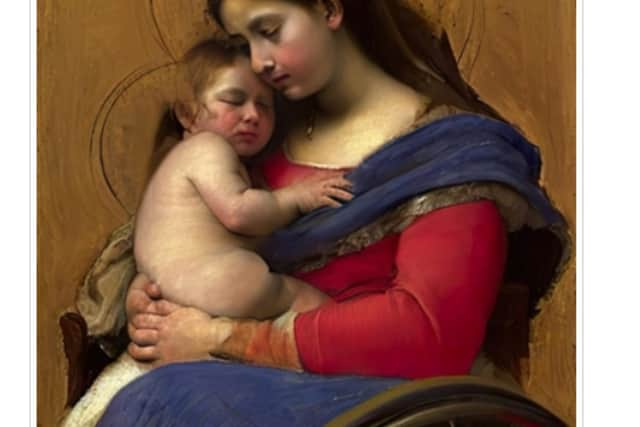Doncaster artist launches trailblazing 'disabled Virgin Mary' exhibition at cathedral
and live on Freeview channel 276
Marc Bratcher, who is severely disabled himself, has unveiled Disability and the Divine, which will run at Peterborough Cathedral until July 7.
His works showcase the Virgin Mary in a wheelchair and are designed to challenge Western stereotypes on religious depictions.
Advertisement
Hide AdAdvertisement
Hide AdSaid Marc: "For many years there has been a tradition of representing key figures from Christianity in ways that reflect different cultural perspectives- such as an African Virgin Mary or an Asian Jesus.


"Indeed, the entire history of western art is part of this tradition, presenting a very Europeanised vision.
"It is in this tradition and inspired by the new climate of inclusivity and stimulating more engagement with the community, that my religious work explores these ideas through the image of Disabled Virgin Mary.
"In my work Mary is a disabled mother, whether she is on her knees in a moment of grief and grace, trying to cradle the body of Jesus as best she can, or trying to hold the infant Christ child as he takes his first steps.
Advertisement
Hide AdAdvertisement
Hide Ad"It is categorically not saying that Mary was disabled and certainly has nothing to do with political correctness, but rather, like those examples above, offers the chance of a significant part of the Christian community, and indeed all society, to see themselves reflected in the Christian story in a way that they never have before.
"Just as in the different cultural examples above, it makes it more relatable to those with a similar perspective.
"It reflects a sector of society which has been woefully underrepresented in the history of religious art – let us not forget that disability was even more commonplace in years gone by than it is today and whilst such images are not essential for the millions of disabled Christians to feel their connection to God or their place in the Christian community, I do think they deserve to be depicted as much as anyone else.
“But even more important than the sociological reasons is the fact that such a project could pose many profound questions of faith and touch on very important theological issues.
Advertisement
Hide AdAdvertisement
Hide Ad"Mary is human like the rest of us, but unlike the rest of us is immaculate and free from original sin.
"This poses profound questions and offers a completely different view on disability. It asks of us: is it not possible to be both a unique symbol of immaculacy and human perfection whilst still being physically different?
"It gets us to think about what perfection is, both of the spirit and of the body.
“Also, there is huge importance and significance in Mary’s embodiment of motherhood. For a long time, the idea of a disabled person being a parent was troubling to many in society, still is to some, and yet for me family and faith are intrinsically linked.
Advertisement
Hide AdAdvertisement
Hide Ad"But perhaps most importantly of all is the fact that the scene depicted in the Pieta, perhaps more than any other in human history, has always represented the limitations of the physical in all of us and the transcendence to something far greater.
"All of which makes the Pieta a perfect and important subject to reinterpreted around the issues of disability and I believe this is also true of the motif of the Madonna and child too.
"Indeed, I have a keen interest in working on a variety of different religious projects myself.
"I want to be honest from the start. I am a respecter of religion rather than particularly devout , and I live perhaps a rather more dissolute and material life than I should, but I believe such work would provide a stimulus and focus for better discussion and a wider understanding of the role the disabled people within society and within the church which better reflects the modern progressive attitudes in the 21st century. I also hope to learn something about my place within them.”
Advertisement
Hide AdAdvertisement
Hide AdThe exhibition will be open during the usual Cathedral opening times. Visiting times can vary due to services and events. Please check beforehand to avoid disappointment.
Entry to the Cathedral is by donation.